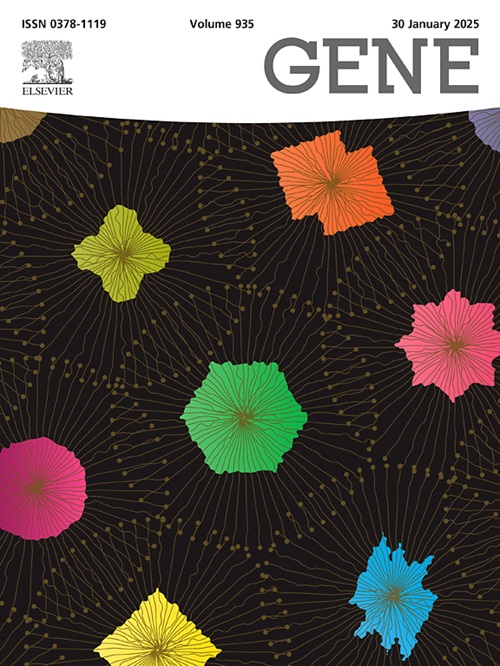多组学测序分析揭示了瘢痕疙瘩中与氧化应激、线粒体和免疫细胞有关的关键机制。
IF 2.4
3区 生物学
Q2 GENETICS & HEREDITY
引用次数: 0
摘要
背景:本研究旨在通过整合氧化应激、线粒体和免疫细胞,研究瘢痕疙瘩发病的关键分子机制:本研究旨在通过整合氧化应激、线粒体和免疫细胞,研究瘢痕疙瘩发病的关键分子机制:方法:对瘢痕疙瘩患者的皮损和非皮损皮肤以及健康对照(正常)皮肤进行转录组测序(mRNA、lncRNA和circRNA表达数据)、蛋白质组测序和小RNA测序分析。通过整合 mRNA 和公开的基因表达数据(GSE158395),确定了瘢痕疙瘩中与氧化应激和线粒体功能相关的差异表达基因。通过各种生物信息学分析,如免疫浸润分析、加权基因共表达网络分析、机器学习和使用蛋白质组学测序数据进行表达验证,确定了枢纽基因。此外,通过结合 miRNA、lncRNA 和 circRNA 表达数据,构建了枢纽基因的竞争性内源性 RNA(ceRNA)网络。结果发现了五个枢纽基因:MGST1、DHCR24、ALDH3A2、ADH1B和FKBP5:这些中心基因对瘢痕疙瘩具有很高的诊断价值,每个基因的 AUC 值均大于 0.8。此外,有五个中心基因与多种免疫细胞的浸润有关。与中枢基因正负相关性最强的免疫细胞是M0和M1巨噬细胞。构建了一个ceRNA网络,发现了几个ceRNA,如AC005062.1/miR-134-5p/FKBP5和BASP1-AS1/miR-503-5p/ADH1B。这五个枢纽基因可能对瘢痕疙瘩的发病机制有贡献:这些基因及其相关的 ceRNA 可作为瘢痕疙瘩的诊断生物标志物和治疗靶点。本文章由计算机程序翻译,如有差异,请以英文原文为准。
Integrating multiomics sequencing analyses uncover the key mechanisms related to oxidative stress, mitochondria, and immune cells in keloid
Background
This study aimed to investigate the key molecular mechanisms underlying keloid pathogenesis by integrating oxidative stress, mitochondria, and immune cells.
Methods
Transcriptome sequencing (mRNA, lncRNA, and circRNA expression data), proteomic sequencing, and small RNA sequencing analyses of lesional and non-lesional skin of patients with keloids and healthy control (normal) skin were conducted. By integrating mRNA and publicly available gene expression data (GSE158395), differentially expressed genes related to oxidative stress and mitochondrial function in keloids were identified. Hub genes were identified using various bioinformatics analyses such as immune infiltration analysis, weighted gene co-expression network analysis, machine learning, and expression validation using proteomics sequencing data. Moreover, a competing endogenous RNA (ceRNA) network of hub genes was constructed by combining miRNA, lncRNA, and circRNA expression data. Five hub genes were identified: MGST1, DHCR24, ALDH3A2, ADH1B, and FKBP5.
Results
These hub genes had a high diagnostic value for keloids, with an AUC value > 0.8 each. In addition, five hub genes were associated with the infiltration of multiple immune cells. The immune cells with the strongest positive and negative correlations with hub genes were M0 and M1 macrophages. A ceRNA network was constructed, and several ceRNAs, such as AC005062.1/miR-134-5p/FKBP5 and BASP1-AS1/miR-503-5p/ADH1B, were identified. These five hub genes may contribute to keloid pathogenesis.
Conclusion
These genes and their related ceRNAs may serve as diagnostic biomarkers and therapeutic targets for keloids.
求助全文
通过发布文献求助,成功后即可免费获取论文全文。
去求助
来源期刊

Gene
生物-遗传学
CiteScore
6.10
自引率
2.90%
发文量
718
审稿时长
42 days
期刊介绍:
Gene publishes papers that focus on the regulation, expression, function and evolution of genes in all biological contexts, including all prokaryotic and eukaryotic organisms, as well as viruses.
 求助内容:
求助内容: 应助结果提醒方式:
应助结果提醒方式:


